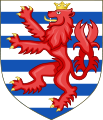- Coat of arms of Luxembourg
-
Coat of arms of Luxembourg 
Details Armiger Grand Duchy of Luxembourg Crest A grand-ducal crown or Escutcheon burely of 10 argent and azure, a lion rampant queue fourché in saltire gules armed, langued and crowned or increased the ribbon and the cross of the Order of the crown of oak passed around the shield Supporters Two lions reguardant, crowned and with forked tails looped or armed and langued gules standing on a compartment or Other elements the whole resting on a mantle Gules lined with ermine, lined, fringe, cords and tassels of gold, summoned to the grand-ducal crown Unlined. The coat of arms of Luxembourg has its origins in the Middle Ages, and was derived from that of the Duchy of Limburg, in modern day Belgium and the Netherlands. In heraldic language, these arms are described as: burely of 10 argent and azure, a lion rampant queue fourché in saltire gules armed, langued and crowned or.
Contents
Versions
There are greater, middle and lesser versions of the coat of arms of Luxembourg.The greater coat of arms has two reguardant and crowned lions as supporters, the Dinastic Order and all surrounded by hermine mantling crowned with a heraldic royal crown (the crown used by the Grand Duke). The middle coat of arms has the supporters, the order and the crown. The lesser coat of arms has the crown and the escutcheon without external ornaments.
Arms of the Monarch
The Grand Duke has a personal arms:
Quarterly: 1 and 4 Luxembourg, 2 and 3 Nassau (Blazon: Azure billetty Or, a lion or armed and langued Gules). The lesser variant of the arms of the monarch has no external ornaments. The middle variant has the supporters, the order and the crown.
The greater variant has a dinastic inescutcheon with the arms of the House of Bourbon-Parma (Blazon: Azure bordure Gules charged with eight escallops Argent, three fleurs-de-lys Or). The supporters are holding a lance Or, flying the flag of Luxembourg, all surrounded by hermine mantling with the crown.
The coat of arms of Henry V, Count of Luxembourg (1216–1281)
Henry V was the first Count of Luxembourg to adopt a primitive form of these arms. His father, Waleran III, Duke of Limburg, bore the arms, argent a lion rampant queue fourché gules armed, langued and crowned or (white field bearing a red double tailed lion with yellow claws, teeth, tongue and crown). Henry V replaced the white field by a series of white and blue stripes (burely of 10 argent and azure) to differentiate from his half-brother Henry IV, Duke of Limburg.
It is yet uncertain where the origins of this burely of 10 argent and azure are. Jean-Claude Loutsch, Luxembourg's most prominent heraldist, authored the theory that the original Luxembourg dynasties may have born a striped banner (colours unknown). Two dynasties closely related to the first Houses of Luxembourg also adopted striped coats of arms during this period. Both the Counts of Loon and Counts of Grandpré bore the arms burely of 10 or and gules (yellow and red alternating stripes). In such a case, the choice of colour of the stripes would have been determined to match the white field and red lion of Limburg.
The coat of arms of Henry VI, Count of Luxembourg (1240-1288)
In 1282, after the death of Waleran IV of Limburg, Henry VI, count of Luxembourg changed his arms by doubling the lion's tail and passing it in saltire as a claim on the duchy of Limburg. After Henry VI’s death in 1288 at the Battle of Worringen, Henry VII readopted his grandfather Henry VII’s arms, which remained in use until the extinction of the House of Luxembourg.
References
- Armorial du pays de Luxembourg, Dr. Jean-Claude Loutsch, Publications nationales du Ministère des Arts et des Sciences, Luxembourg 1974
See also
Coats of arms of Europe Sovereign
states- Albania
- Andorra
- Armenia
- Austria
- Azerbaijan
- Belarus
- Belgium
- Bosnia and Herzegovina
- Bulgaria
- Croatia
- Cyprus
- Czech Republic
- Denmark
- Estonia
- Finland
- France
- Georgia
- Germany
- Greece
- Hungary
- Iceland
- Ireland
- Italy
- Kazakhstan
- Latvia
- Liechtenstein
- Lithuania
- Luxembourg
- Macedonia
- Malta
- Moldova
- Monaco
- Montenegro
- Netherlands
- Norway
- Poland
- Portugal
- Romania
- Russia
- San Marino
- Serbia
- Slovakia
- Slovenia
- Spain
- Sweden
- Switzerland
- Turkey
- Ukraine
- United Kingdom
- (England
- Northern Ireland
- Scotland
- Wales)
- Vatican City
States with limited
recognition- Abkhazia
- Kosovo
- Nagorno-Karabakh
- Northern Cyprus
- South Ossetia
- Transnistria
Dependencies
and other territories- Åland
- Faroe Islands
- Gibraltar
- Guernsey
- Jan Mayen
- Jersey
- Isle of Man
- Svalbard
Other entities Categories:- National symbols of Luxembourg
- National coats of arms
Wikimedia Foundation. 2010.











